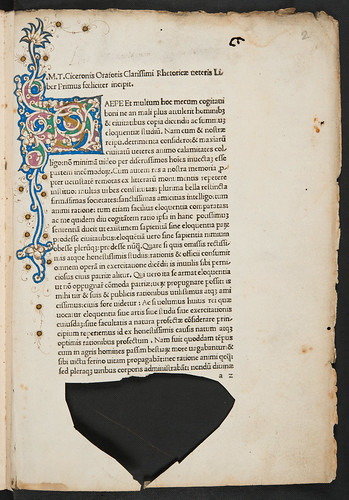Cicero, Marcus Tullius: De inventione, sive Rhetorica vetus.
Edited by Omnibonus Leonicenus.
[Venice: Filippo di Pietro], 1475.
Fol. a10 b-g8. [58] leaves, the first blank.
ISTC ic00645000; Goff C645; BMC V 219; GW 6734.
| Shelf-mark: | Sp Coll Hunterian Be.3.29 (see main library entry for this item) |
| Variant: | a2r, line 3: “[ ]AEPE Et ...” as in the Bayerische Staatsbibliothek copy (electronic facsimile), not as GW “[ ]AEPE ET ...”. |
| Bound with: | The first of two incunabula bound together. Bound (as in many other copies) with: Cicero, Marcus Tullius, Rhetorica ad C. Herennium. [Venice?: Printer of Datus, ‘Elegantiolae’ (H 5969*), ca. 1475]. |
| Provenance: | Petrus Desentianus(?) - 16th-century: partially erased inscription on a1r “Iste Liber est mei petri desent[...]”. Joannes de Peregrinis (16th/17th century): inscription on a1r “Joa: de Peregrinis”. Venice, Capuchins: partially erased inscription on a2r “Loci Venetiarum Capuccinorum”; the same inscription appears on g6v of the second item in volume. Robert Hoblyn, (1710-1756), politician: 'Bibliotheca Hoblyniana' (Londini: J. Murray, 1769), p. 213; Hoblyn sale, 2 March 1778 onwards; lot 3411 in 'Bibliotheca Hoblyniana ...' (London: Baker & Leigh, 1778). William Hunter (1718-1783), physician and anatomist: purchased by Hunter at the Hoblyn sale for £1.7.0 according to the annotated British Library copy of the Hoblyn sale catalogue - shelfmark S.C.S. 11 (4). |
| Binding: | Italy, 16th-century blind-tooled, brown goatskin over bevelled wooden boards. Covers decorated with fillets to form three frames and a centre panel; the latter has a reticulated design formed from an interlaced tool and is further decorated with a small annulus-shaped tool used singly or in groups of seven; the inner frame is decorated with a chain-like pattern formed by an interlaced dotted tool (cf. Weale, 'Bookbindings', fig. 13 (lower right), p. xviii); the middle frame is decorated with a small annulus-shaped tool used singly; the outer frame is decorated with a rope-like pattern formed by a dotted s-shaped tool, a six-petalled flower stamp and a lattice stamp. Rebacked in 19th/20th century and new flyleaves added at front and rear; original spine covering not preserved; no evidence of pastedowns. Remains of two clasps, with brass catch plates on rear board and in a corresponding position on the front board are brass rivets decorated with a star-shaped design. Manuscript title on fore-edge ‘Retorica Tulii’ running from head to tail. Size: 297 x 205 mm. |
| Leaf size: | 290 x 202 mm. |
| Annotations: | Frequent marginal annotations in humanist hands in black ink and in faded red; frequent interlinear corrections of text; signature f1, which is wrongly signed “d”, is corrected by hand in ink; 18th-century shelfmark “f5 sh” and “f5” in pencil on a1r. |
| Decoration: | Six-line initial “S” on a2r and six-line initial “C” on d2r supplied in gold and embellished with white-vine decoration defined in blue, green and purple with a pattern of white dots, which extends into the inner and upper margins (an initial in the second item in the volume is by the same illuminator); other initials supplied in red or blue, with evidence of guide-letters in brown ink. |
| Imperfections: | Large triangular excision in lower margin of a2r (probably indicating removal of ownership evidence). |





